The Acer Swift 3 SF314 Notebook Review: Swift Gets Swifter With Ryzen 4000
by Brett Howse & Andrei Frumusanu on May 5, 2020 8:00 AM ESTBattery Life
While AMD’s rebirth in the notebook market brought with it some changes that have shaken up the laptop market, one area where AMD’s Ryzen APUs have suffered is in terms of battery life. Thanks to a high base power draw, both the AMD Ryzen 2000 and 3000 series could not match the competition in terms of outright battery life. With the new Ryzen 4000 series, AMD has not only moved to the Zen 2 CPU cores, but also to the 7 nm TSMC process, so they should have a chance to rectify their previous shortcomings.
Despite the 14-inch notebook size, the Acer Swift 3 ships with just a 48 Wh battery, which is much smaller than you would see as an average for this size of device. Of course battery capacity is only one side of the equation, with the other being power draw, so to test the overall battery life the notebook was run through our laptop battery suite, which consists of a low-impact web test, a high-impact web test, and movie playback from a local file. As always, the display is set to 200 nits of brightness to normalize display power across all of the notebooks.
Light Battery Life
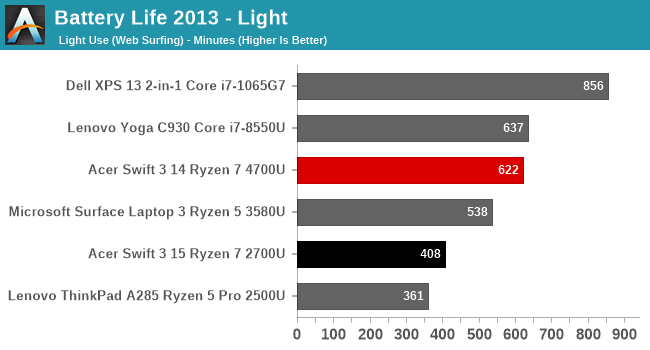
The Acer Swift 3 does quite well in our lightest test, offering over ten hours of screen-on time. A great comparison is the Microsoft Surface Laptop 3 15-inch, which had Picasso and a battery of similar capacity.
Web Battery Life
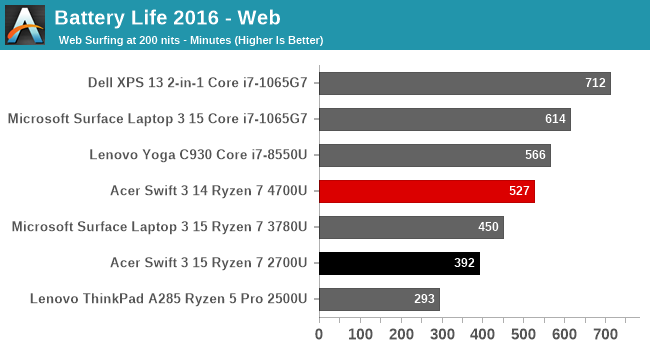
Our revamped web test is much more demanding on the CPU, and generally especially impacts thin and light designs where the base power draw is quite low. That is the case here, with almost 100 minutes less runtime than the light battery test. But the results are still encouraging, with almost nine hours of runtime.
Movie Playback
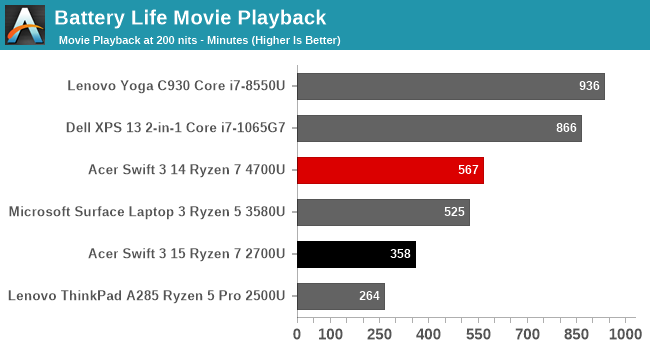
The Acer Swift 3 offers good battery life with the movie playback as well, closing in on ten hours straight with the display at 200 nits brightness. This is one area where the previous AMD APUs struggled, since it does mean offloading the video decode to the GPU. Intel has incredibly efficient hardware blocks dedicated to this, and the AMD APU can’t quite match that, but is still an improvement over Picasso.
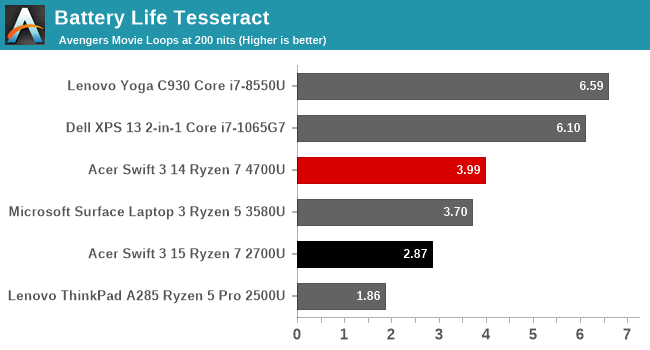
In terms of overall movie playback time, the Acer Swift 3 would let you watch four complete sittings of The Avengers in a row, although you’d miss the end of the credits in the final loop.
Normalized Battery Life

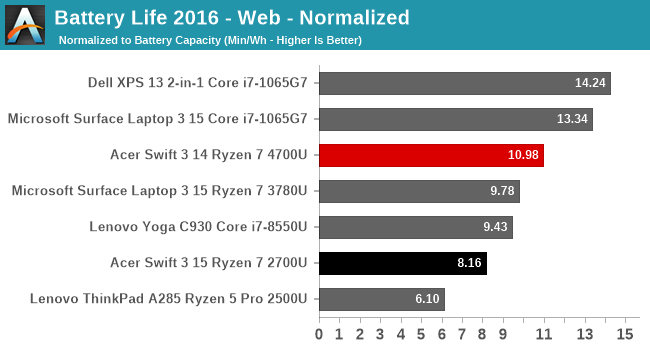
Removing the battery size from the battery life equation lets us take a look at platform efficiency across the different notebooks. In our light test, there is a big jump in efficiency when comparing to the Microsoft Surface Laptop 3 AMD edition, and as the light test is mostly an idle scenario, gives hope that Renoir has finally solved AMD’s extra power draw. The Web test is more demanding, meaning more CPU power is used, and only shows a small gain over the previous generation.
Platform Power Draw
To get an idea how much power draw there is on the new Renoir based platform, we turned to BatteryBar Pro to log the power draw. The results were impressive. AMD has more or less matched Intel in terms of idle power usage with their Ryzen 4000 series.
The first-generation Acer Swift 3 with Ryzen 5 2500U drew around 2.55 watts at idle, but the new Ryzen 7 4700U Acer Swift 3 idled right around 1.0 Watts, matching the 10th generation Intel Ice Lake equipped Surface Laptop 3. This is a big step for AMD, and allows them to compete not just on performance, but battery life as well.
Battery Life Conclusion
Despite the smaller than average 48 Wh battery capacity, the updated Ryzen 7 4700U in the Acer Swift 3 manages to provide solid battery life. This is a big win for AMD, where battery life was one of the key drawbacks to their previous Ryzen APUs. With right around 1.0 Watts of idle power draw with the screen off, they are no longer playing catch-up to the competition. For light tasks, it should easily get through the day.
Charge Time
Acer includes a 65-Watt A/C adapter with the Swift 3, providing more than enough output to power this laptop. As previously mentioned though, the included connector is a barrel connector, which in itself is not a huge issue, except that Acer’s barrel connectors are very thin and would be prone to breaking. This has been a concern on their notebooks for some time. The good news is that the notebook also has a USB-C connector with power delivery, and you can charge the laptop over USB-C with no issues. Despite the convenience, USB-C is still an expensive standard, so some vendors have not made the switch on all of their devices yet.
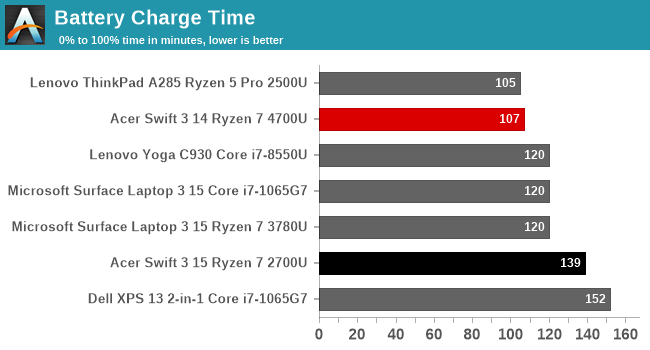
As far as charge time, the 65-Watt charger makes short work of the battery, charging the laptop up to maximum in under two hours. The charge rate peaks around 30 Watts, and Acer claims you can charge four hours of battery usage in 30 minutes of charge time.


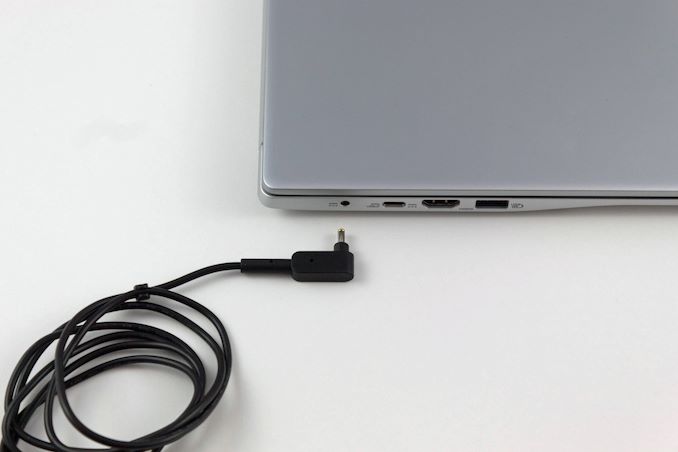








191 Comments
View All Comments
lightningz71 - Tuesday, May 5, 2020 - link
It appears that the Acer Swift design philosophy just doesn't translate for anything that requires a high steady-state power draw and thermal load. The Swift had the same issues with the 2XXX and 3XXX series chips as well, so this is nothing new. This is something that Acer has deliberately chosen to make a design trade-off for: sacrifice some thermal dissipation ability to keep the product in the size class that it is intended for.It will be interesting to see the benchmarks on the 4500U in this platform. It was shown in benchmarks of previous versions of the swift that lower end APUs actually performed better in gaming than the top end parts because the system was better able to manage the thermal output and the APU was better able to keep consistent clocks. While the absolute performance was still lower than notebooks with better thermal management implementations, it was a better gaming performer than the top end SKU.
neblogai - Tuesday, May 5, 2020 - link
Generally, you are not complaining about Acer, but about U-series chips from both Intel or AMD. The philosophy of laptops with ~15W chips is that these chips are used in ultrabooks that are responsive and fast in short boosts, and not made for steady power (even if there are some premium devices that offer both).fmcjw - Tuesday, May 5, 2020 - link
The 2019 Swift 5 and LG Gram series were matched to the thermal promises of Intel 10nm chips that took 2 generations to arrive, and maybe 5nm AMD SoCs in 2021 since AMD decided to rush to market with last generation GPU architecture in early 2020. Perhaps with software or AI based optimization, there can be a more optimal mix of processes split between the CPU versus the GPU for best performance within thermal constraints. Not every task is as clear cut as gaming routines, where more of the work is performed more efficiently on the GPU. I'm not sure that will happen though, as such software optimization has the least return on investment outside cloud and data center applications. Not even Apple wants to do it for the 2020 Macbook Air, thermally crippling a fine Intel chip and resolving the issue by sticking a more powerful cooling solution in a Macbook Pro (and charge more).For 2020, Acer managed to get the Swift 3 down to 1.2kg from 1.45kg of the 2019 model through the use of aluminum AND magnesium (not just aluminum as the article states). The 2020 Swift 5 maintains a 1kg weight while including a rare-breed matte touch screen. The Swift 5 is the model you want to get for 100% sRGB at a $300 premium. I think the only reason these fine machines sell for $600 to $900 for a mid-range configuration is the thermally constrained performance of the more stubbornly ambitious SoCs.
Which if they can think outside the box can easily resolve by selling a fan-assisted cooling dock and unleash the full potential of the SoC we already paid for (and charge more).
Fulljack - Tuesday, May 5, 2020 - link
while Vega here is based on GCN 5 and not RDNA, it doesn't mean it's an outdated architecture. AMD did enhance the Vega arch for Ryzen 4000, with 56% improvement over Vega arch found in Ryzen 3000. overall, with enhanced arch, reduced core count, and higher clock, AMD did deliver 2020 Vega 8 that performs 28% better than 2019 Vega 11.https://www.anandtech.com/show/15324/amd-ryzen-400...
Oxford Guy - Thursday, May 7, 2020 - link
All irrelevant when the laptop's cooling is so pathetic:"The laptop really struggled with its thermals, dropping the framerate into single digits often. The device attempted to run at around 18 Watts of power draw, slightly over the 15 Watt TDP, but in fact only averaged around 8 Watts during this run."
csp4me - Tuesday, May 5, 2020 - link
Acer Swift 3 and 5 are in the market for lightweight, cool & quiet laptops within thermal constraints, thus ~ 18W tdp, and throttling under stress test.For the same budget of Acer Swift 5 ~ $900 you can find laptop models with the same quality display or better and also better thermals ~ 28W-35W at the expense of weight 1.3-1.4kg and noise/heat during heavy loads. Examples Lenovo Ideapad S540-13 both AMD or Intel, or Yoga Slim 7 both AMD or Intel.
psychobriggsy - Tuesday, May 5, 2020 - link
When you buy low power laptops - Y or U series TDPs - you are really looking out for these things1) Sustained Single Core Clock
2) Sustained All-Core Clock
3) Race-To-Sleep Single Core Turbo Boost (and the time it can sustain this)
4) Race-To-Sleep All-Core Turbo Boost (and the time it can sustain this)
1 and 2 are what your gaming sessions will occur in. 3 and 4 might help in some particularly CPU-heavy parts, but only for small periods of time.
This is the problem Intel have with their 14++++ chips - 1 and 2 cannot be raised in the TDP they are restricted to (unlike desktop, where they can simply lie about the figures, in a laptop this will affect battery life and be easily detected), so they hype 3 and 4 to compensate.
AMD on 7nm does well in all four measures, but you should never think you'll get long-term turbo clock performance from any mobile chip. I don't know if Renoir has a 4C turbo that can last longer than the 8C turbo for lightly threaded loads.
fmcjw - Tuesday, May 5, 2020 - link
Can a Y or U series SoC be considered the equivalent of an H series SoC internally, with a beefier cooling solution and reduced I/O capabilities externally? I imagine not just the I/O or cooler but also the capacitors and power circuitry need to be higher specified for the higher sustained load.It's just that few makers even try to create a balanced system around the U or Y series, letting Turbo Boost go wild to impress for the first minute or two, or restraint the system thermally to achieve longer battery life even when you can plug it in.
T1beriu - Tuesday, May 5, 2020 - link
>the mobile chips here only feature half the L3 cache compared to its desktop counterpartsSmall correction. Ryzen 4000 actually has a quarter.
ads295 - Tuesday, May 5, 2020 - link
Acer has consistently impressed me with their attention to detail. There are so many moronic OEMs that put in a single module of RAM but even my 2016 Acer E5-553-T4PT came with 2 modules of 2GB DDR4 RAM to enable the A10-9600P to run in dual channel mode.I suppose they don't get paid to debilitate AMD setups.